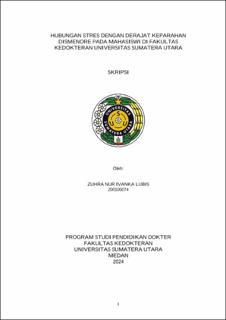Hubungan Stres dengan Derajat Keparahan Dismenore pada Mahasiswi di Fakultas Kedokteran Universitas Sumatera Utara
The Relationship of Stress with The Severity of Dysmenorrhea in Female Student at The Faculty of Medicine, University of North Sumatra

Date
2024Author
Lubis, Zuhra Nur Ivanka
Advisor(s)
Eyanoer, Putri Chairani
Metadata
Show full item recordAbstract
Background: Dysmenorrhea occurs due to excessive release of prostaglandins which
causes increased uterine contractions resulting in pain during menstruation. When
stressed, the body will overproduce the hormones adrenaline, estrogen and prostaglandins.
Excessive adrenaline hormone can cause increased muscle tension throughout the body
including the uterus, which can increase excessive contractions during menstruation,
causing dysmenorrhea. Excessive estrogen hormone causes increased uterine
contractions. Meanwhile, an increase in the hormone prostaglandin will cause uterine
muscle contractions and can cause vasospasm of the uterine arterioles resulting in
ischemia and cramps in the lower abdomen which will stimulate pain.
Objective: To analyze the relationship between stress and the occurrence of
dysmenorrhoea in female students at the Faculty of Medicine, University of North Sumatra
Method: This research design was chosen because the researcher wanted to find out the
correlation between stress levels and the incidence of dysmenorrhea using a case series
approach which prioritizes time measurement/observation of independent and dependent
variable data only once at a time. Instruments are used to collect detailed data so that
valid, reliable and actual data is obtained. In this research, data collection used a
questionnaire/google forms. The instruments used were a stress level questionnaire
(Kessler Psychological Distress Scale), and a dysmenorrhea questionnaire (Numeric Pain
Rating Scale). Bivariate analysis will be carried out using the Person Correlation test if
the data is normally distributed and using the Spearman Correlation test if the data is not
normally distributed
Results: Based on the results of the Kolmogorov-Smirnov normality test, it was found that
the data were normally distributed, so the data analysis used Pearson correlation. Based
on the results of data analysis, a p-value of 0.000 was obtained which was smaller than the
significance value α (0.05), indicating that H1 was accepted, indicating a relationship
between stress levels and the incidence of dysmenorrhea. The Pearson correlation value is
0.583 which indicates that the level of stress has a moderate correlation with the incidence
of dysmenorrhea.
Conclusion: In this study, it was found that most female students experienced a regular
menstrual cycle. It was found in this study that the majority of female students had
nutritional status in the normal category. In this study it was found that the age of menarch
was mostly at the age of > 12 years. The stress level in this study was the highest in the
mild category stress level. The incidence of dysmenorrhea in female students illustrates
that most experience dysmenorrhea. The results showed that there was a moderate
correlation between the level of stress and the incidence of dysmenorrhea in female
students.
Collections
- Undergraduate Theses [2309]
